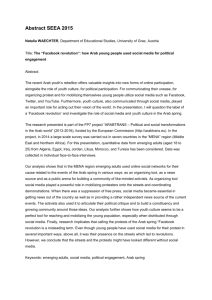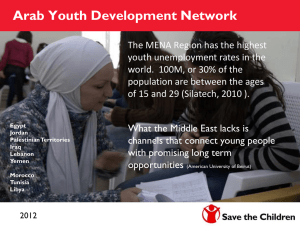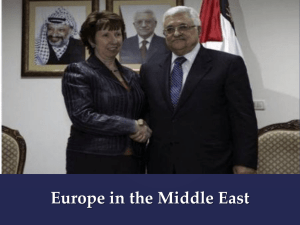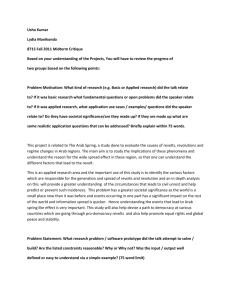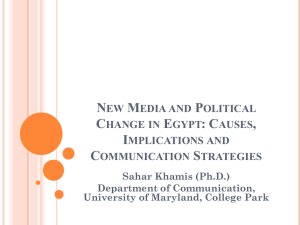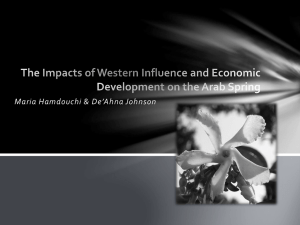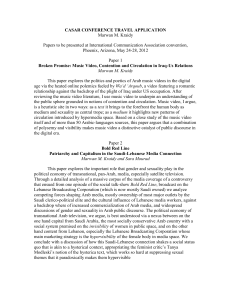Arab DRR Conference 2013_concept note
advertisement
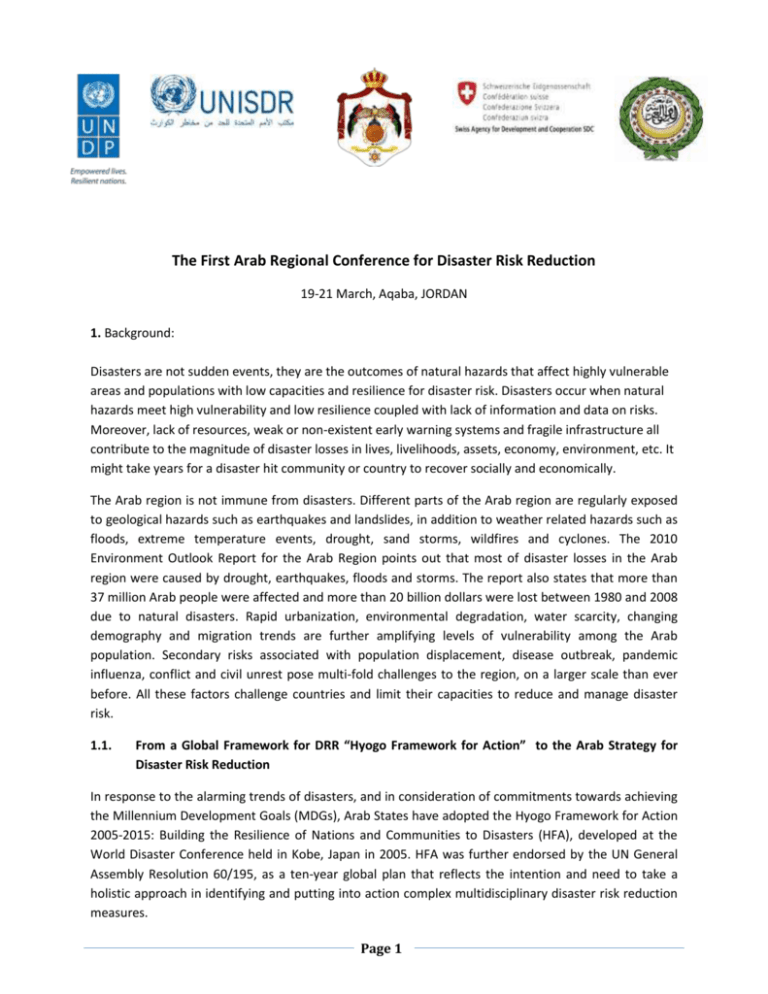
The First Arab Regional Conference for Disaster Risk Reduction 19-21 March, Aqaba, JORDAN 1. Background: Disasters are not sudden events, they are the outcomes of natural hazards that affect highly vulnerable areas and populations with low capacities and resilience for disaster risk. Disasters occur when natural hazards meet high vulnerability and low resilience coupled with lack of information and data on risks. Moreover, lack of resources, weak or non-existent early warning systems and fragile infrastructure all contribute to the magnitude of disaster losses in lives, livelihoods, assets, economy, environment, etc. It might take years for a disaster hit community or country to recover socially and economically. The Arab region is not immune from disasters. Different parts of the Arab region are regularly exposed to geological hazards such as earthquakes and landslides, in addition to weather related hazards such as floods, extreme temperature events, drought, sand storms, wildfires and cyclones. The 2010 Environment Outlook Report for the Arab Region points out that most of disaster losses in the Arab region were caused by drought, earthquakes, floods and storms. The report also states that more than 37 million Arab people were affected and more than 20 billion dollars were lost between 1980 and 2008 due to natural disasters. Rapid urbanization, environmental degradation, water scarcity, changing demography and migration trends are further amplifying levels of vulnerability among the Arab population. Secondary risks associated with population displacement, disease outbreak, pandemic influenza, conflict and civil unrest pose multi-fold challenges to the region, on a larger scale than ever before. All these factors challenge countries and limit their capacities to reduce and manage disaster risk. 1.1. From a Global Framework for DRR “Hyogo Framework for Action” to the Arab Strategy for Disaster Risk Reduction In response to the alarming trends of disasters, and in consideration of commitments towards achieving the Millennium Development Goals (MDGs), Arab States have adopted the Hyogo Framework for Action 2005-2015: Building the Resilience of Nations and Communities to Disasters (HFA), developed at the World Disaster Conference held in Kobe, Japan in 2005. HFA was further endorsed by the UN General Assembly Resolution 60/195, as a ten-year global plan that reflects the intention and need to take a holistic approach in identifying and putting into action complex multidisciplinary disaster risk reduction measures. Page 1 The League of Arab States, through the Council of Arab Ministers Responsible for the Environment (CAMRE), has taken concrete steps toward increasing awareness and commitment to disaster risk reduction and the integration of disaster risk reduction measures in regional policies on sustainable development, climate change adaptation, environment and disaster management coordination mechanisms. This is evident in the Arab Ministerial Declaration on Climate Change adopted by CAMRE at its 19th session held 5-6 December 2007. The Declaration among other recommendations stresses the potential risks of climate change and calls for adaptation programmes to “include appropriate mechanisms for risk insurance, improvement in the management and efficiency of natural resources through the use of appropriate techniques and advanced monitoring, control and early warning systems, as well as adequate preparedness to confront disasters caused by climate change”. A major achievement was also realized during the 20th session of CAMRE, held on 20-21 December 2008 during which CAMRE adopted a decision (No. 295) calling for increased cooperation and coordination with the ISDR thereby placing the follow-up to the implementation of the HFA as a permanent agenda item for CAMRE and its subsidiary body the “Joint Committee for Environment and Development in the Arab Region”. CAMRE also urged the Arab states to systematically report on progress in implementation of the HFA each biennium. In 2008-09, Arab participation in the first biennial review of progress in implementation of the HFA led to the release of a regional synthesis report on Progress in Implementation of the HFA for the Arab region. Deriving from initial findings, CAMRE adopted actions relating to disaster risk reduction as a follow-up to the 1st Arab Summit on Socio-Economic Development. In an important decision, member states approved the need to develop an Arab Strategy for Disaster Risk Reduction (ASDRR) and also called for the establishment of an Arab regional platform for disaster risk reduction (at the ministerial and multi-stakeholder level) to accelerate the implementation of the HFA at the regional, national and local level. Following decisions of the League of Arab States, the 1st Arab Strategy for Disaster Risk Reduction 2020 (ASDRR 2020) has been developed in collaboration between the technical secretariat of CAMRE at the League of Arab States, and the United Nations Office for Disaster Risk Reduction (UNISDR) through its Regional Office for Arab States. The strategy development benefited from valuable contributions provided by the United Nations secretariat and specialized agencies, Arab technical organizations, the International Federation for Red Cross and Red Crescent Society, and the World Bank Global Facility for Disaster Reduction and Recovery (GFDRR). The ASDRR takes account of various regional strategies and programmes for disaster risk reduction already developed by the African Union, the Asia-Pacific Economic Cooperation, the Association of South East Asian Nations, the Euro-Mediterranean Programme for the Prevention, Preparedness and Response to Disasters (PPRD), and the Organization of the Islamic Conference (OIC) with the assistance of the United Nations, the World Bank, international development organizations and civil society. The ASDRR 2020 was adopted by CAMRE resolution #345, in its 22nd session held at the League of Arab States 19-20 December 2010 and has been further endorsed by the Economic and Social Council of the Page 2 Arab League in September 2011 and later in March 2012, ASDRR was adopted by Heads of States at the Baghdad Arab Summit. 1.2 Urban Risk Reduction in the Arab States The Arab world is predominantly urban, with over sixty percent of the population living in cities across the region. In certain countries the percentage of urban population is up to 80 %. The growth rate of urban population at 6 % per annum is double then the overall growth rate of the region. Many urban centers including Alexandria, Algiers, Aqaba, Beirut, Casablanca, Jeddah, Tripoli and Tunis are major centers of international commerce and trade. Certain Arab cities have significant historical, cultural and religious importance including Cairo, Damascus, Jerusalem and Sana amongst others. Ironically many of these important commercial and historical cities are exposed to disaster risks from multiple hazards. Seismically generated risks pose significant threats to major urban centers in the Arab States region including earthquakes and tsunami. Many cities are located along four major fault lines; the Dead Sea Transform Fault, the Taurus-Zagros fault, the Nubia-Eurasia plate boundary in Maghreb and the NUAegean Sea and NU-Anatolia (AT) in Eastern Mediterranean region. Historically Beirut, Damascus, Allepo, Agadir, Algiers and Alexandria have been destroyed due to earthquakes. Cairo, Jerusalem and Latkiah have also experienced earthquakes. Experts anticipate the possibility of large earthquakes in the region in near future, due to active fault lines, and the return period trends of seismic events. Sea intrusion due to climate change and urban fires pose other threats to life and property in these centers. In recent years various cities have also experienced devastating flash flooding; including Jeddah and Riyad in Saudi Arabia. A number of factors have enhanced the exposure and vulnerability of cities in the Arab region. The explosive increase in urban population over the past decades, coupled with poor land use planning against the potential hazards, the absence of building construction standards and their application, urban poverty and the impact of climate change are some amongst them. Unfortunately most Arab cities have weak policies and institutions for disaster risk reduction. Due to the lack of any major disasters in the recent history, the awareness of communities and authorities is low about the risks posed by latent hazards and the need for preparedness. The urban authorities have the primary responsibility for safety of their citizens, therefore, awareness, capacity and commitment of urban authorities is a prerequisite to promote a culture of disaster prevention in Arab cities. In order to improve safety of Arab citizens and to ensure sustainable social, economic and environmental development it is critical to engage urban authorities in revamping policies and institutional capacities for disaster risk management. Disaster risk management needs to be integrated into regular urban and sectorial development planning. There is a growing interest amongt Arab city authorities to prioritize urban risk issues, which was recently demonstrated by the participation of mayords and governors in a regional urban risk reduction workshop in Cairo, organized by UNDP. Page 3 2. Conference ‘s Strategy and implementation In the above context, UNDP, UNISDR and the Swiss Development Cooperation (SDC) are organizing the First Regional Conference on DRR Challenges and Progress in the Arab Region – including HFA implementation and post 2015 Agenda – with a thematic focus on Urban Disaster Risk Management. The conference will be held on 19-21 March 2013 in Aqaba, Jordan. The Conference will be hosted jointly by UNDP Jordan and Aqaba Special Economic Zone Authority (ASEZA). The Conference is organized in partnership with the League of Arab States and the Jordanian Government and will be attended by national ministers, senior government officials, city mayors, civil society representatives, bilateral development agencies and United Nations officials. The Conference will discuss: i) the existing policies and institutional mechanisms for disaster risk management, ii) the regional progress towards risk reduction and HFA implementation, iii) the regional position and input towards HFA 2 or post-2015 DRR Global Framework, iv) the nature of urban risks in the Arab region and v) good practices on urban risk management. Based upon these discussions, the Conference will formulate and issue a Conference Outcome Statement and a Mayor’s Declaration on Urban Risk Management in Arab Cities. The Mayor’s Declaration will set goals, targets and indicators for reducing disaster risks in the Arab Cities. The Mayor’s Declaration will demonstrate commitment of the participating city authorities to improve their capacities for disaster risk management. The Conference Outcome Statement and the Mayor’s Declaration will also provide the basis for advocacy to city and national governments in the Arab region to enhance and accelerate their actions on disaster risk management. Furthermore, the conference will also debate and discuss current globally evolving issues of concerns with regard to disaster risk reduction in order to understand their implications on the Arab region as well as how to best address them regionally and nationally in the context of Arab regions’ priorities and challenges. These issues include: Making cities, schools and hospitals resilient to disasters including a focus on the role of local authorities and municipalities in urban risk reduction Mitigating and preventing emerging risk due to synchronized disasters caused by natural hazards and leading to technological, nuclear and industrial accidents Strengthening capacity and investments to reduce the risk of large-scale destructive disasters caused by tsunamis and earthquakes. Outcomes: The Conference will launch the Arab Regional Platform on Disaster Risk Reduction as a regional coordination mechanism on DRR that facilitate exchanges among countries and partners and ensure follow-up of progress and engagement of stakeholders in regional and global policies and plans on DRR and sustainable development. In conclusion, an Arab Regional Platform on Disaster Risk Reduction provides a forum where Arab politicians, policy makers, academia and other development experts can periodically discuss issues and challenges facing the region with Page 4 regards to disaster risk reduction, including to increase investment in disaster risk reduction, and to issue policy guidelines. Conference will facilitate development of an Arab position for the 4th session of the Global Platform for Disaster Risk Reduction taking place in Geneva May 2013. Conference will facilitate development of recommendations for HFA 2 (post-2015) The Conference will issue an Arab Mayor’s Declaration on Urban Risk Reduction. The Arab Mayor’s Declaration on Disaster Risk Reduction aims to establish benchmarks for reducing disaster risks in the Arab cities, given the fact that many capital cities and business centers of the Arab region are exposed to variety of disasters, which could lead to colossal losses. Participants Official delegations of the Arab governments representing national focal points for disaster risk reduction in each country Mayors from major high risk Arab cities The Secretariat of the Arab League and all the Arab specialized organizations United Nations organizations and International organizations working in the Arab region with focus on disaster risk reduction Bilateral development agencies Civil society organizations active in the field of risk reduction at the regional level Arab Funds for development, the Islamic Development Bank and the African Development Bank Arab media organizations Representatives from the private sector, insurance corporations concerned with issues of risk reduction and the Union of Arab Investors For Information: Zubair.murshed@undp.org Pelle.lutken@undp.org abu-swaireh@un.org arabdrr2013@gmail.com Page 5

